Basics
As ball-sports go, golf is one of the only non-contact sports to place a weapon in the player’s hand.
Remember, it's a game of complexities, technique and skill. As a player, you should not underestimate the need to learn and practice your craft.
Most golf courses offer lessons to individuals or groups, and these are a great way to learn the basics of the game. Alternatively, you might be better suited to heading down to a driving range one evening and commence hitting a bucket load of balls out into the moonlit abyss. In any case, there are some fundamentals that will help you get started.
You're about to swing a club at a considerable speed. Don't be afraid to stand up as you're reading this and assume the positions described.
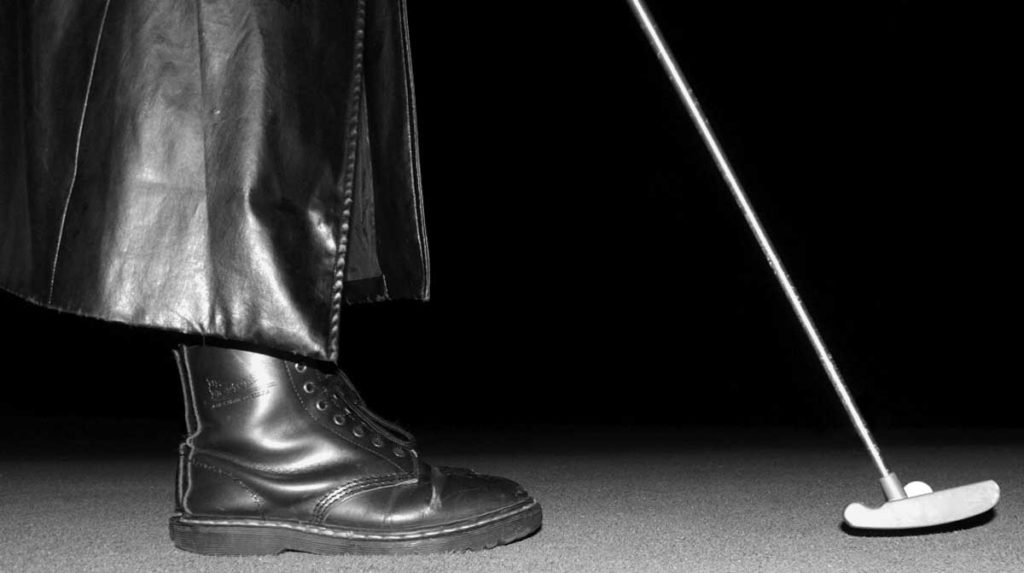
The first thing you need to ensure is that you're facing the right way. You might be laughing now but you'll soon learn that aim is more than just swinging the club in a particular direction. Aim with your feet. Stand so that your whole body – feet, knees, hips and shoulders – are all squared to the direction of travel.
Hold the club with both hands and keep them close together as you hold the club handle loosely. Spread your feet to around the width of your shoulders and bend your knees. Bend from your hips so that your arms hang slightly and stand comfortably so that the ball is in line with the inside of your front foot.
Now you're a golfer! Well, almost. You still have to swing the club in anger a few times. There are a number of different swing 'types', such as a full swing (the kind you might use to smash your neighbour's garden gnomes), the pitch shot (suitable for launching small objects into outer space) and the mini-golf-favourite putting shot that sends the ball home. Mastering these is a matter of morbid curiosity, expert advice and practice which is best learned on a course.
Remember, in order to play the perfect headshot, assess where the ball needs to impact, hold the club with both hands and stand with your body at a right angle to the direction you need the ball to go. You're a natural, but even naturals seek professional help.
Rules
Golf is a fairly universal game but the nature of having a golfing partner, as opposed to a team, means that rules can be tailored and agreed upon between those playing.
Below are some simple rules to get you started but you'll learn much more when you have a night to get out there and start whacking things. All's fair in love, war and golf but Wheaton’s Law still applies: don’t be a dick.
Playing
You play golf by hitting your ball with your desired club. You generally shouldn't manipulate your ball by any other means and certainly not in a way that improves the position of your ball.
Yes, you can move debris, stones etc. if they're in your way but as a general rule, don't break nature – the large scale deforestation that is required to build a golf course has already done that.
If you end up off the fairway, branches will get in your way. This is just part of the game and does not disadvantage you. Try not to break your partner either. Golf is a bonding activity first and a competitive sport second; enjoy your night out.
Lost balls
It's happened to all of us. It's late at night and your glow-in-the-dark ball is the brightest light source around. You see it whizzing off into the nightscape only to lose sight of where it lands.
You have options! You could spend your evening hunting it out amongst the wildlife, ruining the game for you and your partner, or let your partner know you'd like a do-over and hit a second ball from the same location.
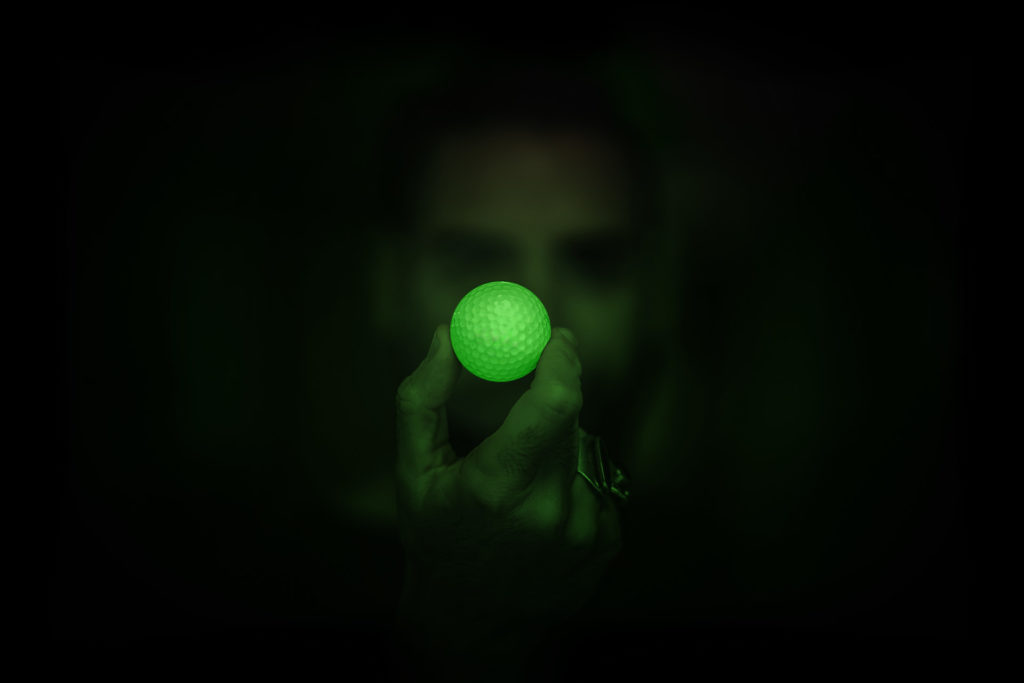
Once you get down to where your second ball landed, spend a few minutes looking for your original ball. If you find it and it's still in bounds, ignore your second shot and play on with the original ball. If not, no worries.
If you do play on with your second ball, then good news everyone! You just incurred a one stroke penalty.
Useless shot
When your ball lands in that awkward moist or hard-to-reach place and you simply can't play it, you can declare the ball as unplayable. For the bargain price of one penalty stroke, you can either replay the ball from where it was last played, or drop the ball within two club lengths of where it landed, as long as it's not closer to the hole.
Obviously this doesn't apply if you're in a trap because that's the whole point of a trap; read on!
It's a trap!
Sometimes your ball is going to end up in all the wrong places. Many courses have hazards that add challenge to the play. In the case of waterways, there are a few of options to stay in the game.
You can retake your entire shot from where the ball was last played, incurring a one stroke penalty. Or, you can try to locate, collect and dry off your ball. If you find it, drop it behind the hazard and play from there, naturally incurring a one stroke penalty.
If your partner agrees, or if the hazard is marked to indicate, you can drop your ball within two club-lengths of the outside of the trap and play from there.
The final option, if you're up for it, is to go for a swim and try hitting the ball underwater. Technically you would incur a one stroke penalty but I'd be so impressed if you pulled it off, I reckon we'd call it square.
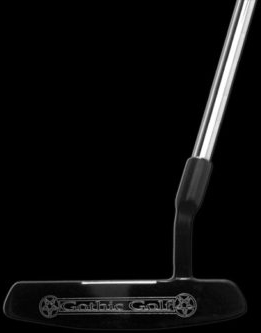
Rules are made to be broken
There are standard "Rules of Golf" that should be respected and some courses may have local or informal rules that you should observe too. However, as the Gothic Golf culture is all about finding your own way, feel free to invent rules with your partner just as long as everyone agrees and they don't impact on other players or the golf course.
Equipment
Knowing what you've got is as important as knowing how to use it. As I curious child, I remember cutting open one of my dad's golf balls to see what was inside. I'm not sure what I used but I'll assume it was a hacksaw. I tightened the ball in his bench vice and furiously cut a hemisphere away, while he was inside grading test papers.
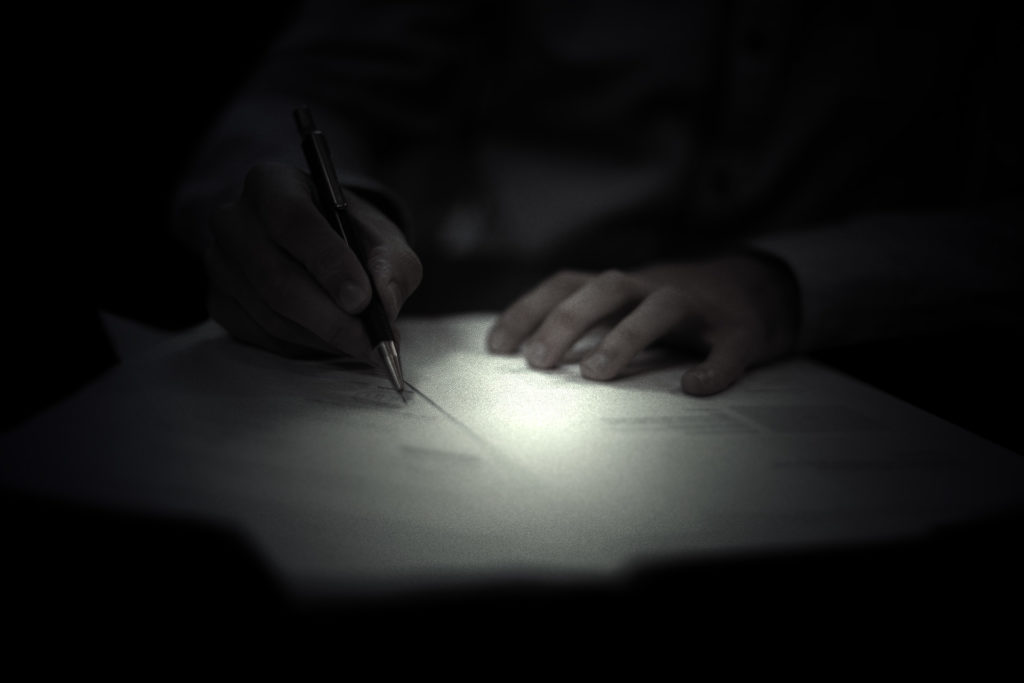
This was my introduction to golf ball construction. Up until then, golf balls had existed only at mini-golf and in my dad's golf bag. I'd take them out and bounce them as hard as I could on the old concrete slab. They were a marvellous thing to a boy of nine; solid to hold, yet like rubber to ricochet around the shed.
So when I cut open this little dimpled ball, I was surprised to find a smaller oily rubber ball inside, wrapped in rubber bands. I bounced it and with every impact, a couple of the small bands flew off in every direction. It was the gift that kept on giving, until after ten or so bounces, it simply had no more to give.
I did what any unattended thrill-seeking child would do after the magic wears off: I grabbed every golf ball in dad's bag and set about cutting them open.
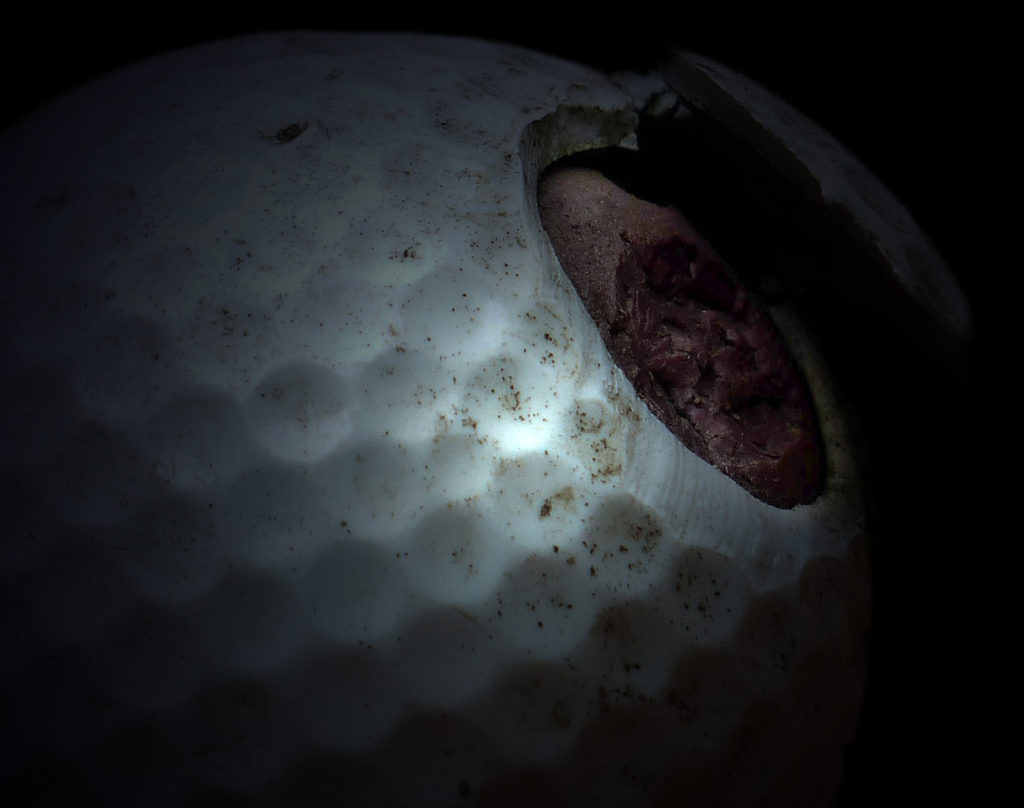
This was the start of some disappointment and confusion. In my childish mind, I had made an assumption that all golf balls were created equal.
I don't know how many more I cut open, but none of them contained the amazing rubber band ball that I was seeking. The rest of them were constructed of solid plastic the whole way through.
But how could this be, I suppose I wondered, when they all looked the same and bounced the same around the confines of the shed? Why were these solid when the first one had contained rubber? The reality of golf balls is you get what you pay for.
There are balls with liquid centres, feather centres, and yes, rubber centres like my first victim of a ball. Then there are one-piece balls that are made from solid Surlyn. They’re okay for hitting into the distance, never to be seen again but for the scream of a neighbour, but they rarely make it onto the competitive golf course.
Gothic Golf is a different beast, and it's a challenge for night-golf no matter where you play. Dare I say it without cracking a smile: you want to have balls you can see in the dark.
There are several options available and the choice gets a whole lot easier with online shopping. I've made the mistake of sauntering into a city golf shop and trying to get the right kind of attention from the sales staff.
Ask for glow-in-the-dark golf balls and at best you’ll be directed to high-vis balls. Fluorescent testicles notwithstanding, a quick web search will help you locate a suitable alternative.
There are primarily three types of golf balls which are suitable for night time play.
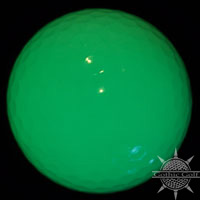 1. Phosphorus coated balls need to be charged from a light source and typically glow with a greenish tinge. They are essentially a traditional golf ball that has a phosphorus boundary layer, so you may find there is some variety of construction methods available. Depending on the construction, they should travel just as accurately as the balls sold at the pro store. The drawback to phosphorus balls is that they need to be recharged during the game, so remember to bring a torch.
1. Phosphorus coated balls need to be charged from a light source and typically glow with a greenish tinge. They are essentially a traditional golf ball that has a phosphorus boundary layer, so you may find there is some variety of construction methods available. Depending on the construction, they should travel just as accurately as the balls sold at the pro store. The drawback to phosphorus balls is that they need to be recharged during the game, so remember to bring a torch.
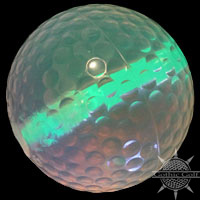 2. Glow-stick balls are usually transparent golf balls that have a hole drilled through the centre. A small glow-stick is inserted to illuminate the ball and like typical glow-sticks, these needs to be replaced after each use. Still, they'll usually last for the whole of the game so there's no need to worry about losing your ball. On the plus side, they come in a range of colours which helps to distinguish your balls from the others, but like any aerodynamic and weighted object that is hit through the night sky, drilling a hole through it is bound to alter the properties of its trajectory. There's also the chance that the club will clip the glow-stick and explode it, but this is seen more as a rite-of-passage than a faux pas.
2. Glow-stick balls are usually transparent golf balls that have a hole drilled through the centre. A small glow-stick is inserted to illuminate the ball and like typical glow-sticks, these needs to be replaced after each use. Still, they'll usually last for the whole of the game so there's no need to worry about losing your ball. On the plus side, they come in a range of colours which helps to distinguish your balls from the others, but like any aerodynamic and weighted object that is hit through the night sky, drilling a hole through it is bound to alter the properties of its trajectory. There's also the chance that the club will clip the glow-stick and explode it, but this is seen more as a rite-of-passage than a faux pas.
 3. LED balls are becoming increasingly common and for good reason. I'm not sure what's going on in there exactly, but there's a battery and a couple of bright LEDs that activate on impact. You can either drop it on a hard surface to activate the light, or trust that your swing will be violent enough to light it up as it's streaking through the air. Depending on the brand, the LEDs will stay on for around 5-8 minutes, hopefully giving you time for your next shot before you're left in the dark. Again, LEDs come in a variety of colours so there's plenty of choice. The catch is the possible irregularity and variance of their weight, and the fact they're a sealed unit means they have a finite life of around 20 hours battery time before they're relegated to bottom of the bag.
3. LED balls are becoming increasingly common and for good reason. I'm not sure what's going on in there exactly, but there's a battery and a couple of bright LEDs that activate on impact. You can either drop it on a hard surface to activate the light, or trust that your swing will be violent enough to light it up as it's streaking through the air. Depending on the brand, the LEDs will stay on for around 5-8 minutes, hopefully giving you time for your next shot before you're left in the dark. Again, LEDs come in a variety of colours so there's plenty of choice. The catch is the possible irregularity and variance of their weight, and the fact they're a sealed unit means they have a finite life of around 20 hours battery time before they're relegated to bottom of the bag.
If you’ve found other options, please let us know so I can update this list. In closing, I can't stress enough that no matter which type, or whose balls you chose to play with, remember to check if they're legal at your course or club-house before you play. There's no point beating your personal best only to be accused of using loaded balls. Yeah, you read that right.
Scoring
Once you get over the notion that you can basically win by just refusing to play, it actually sets a unique challenge. See, the aim of golf is to have the lowest score and to get the lowest score, you need to have made as few strokes with the club as possible.
Each hole you play on will have a predetermined par. This is the number of strokes that the masochistic curator of the course has decided is reasonable.
Typically, your score will be the difference between the par and the number of strokes (and penalty strokes) it takes you to complete the hole.
The following terminology is used for scoring above or below par.
| Numeric term | Name | Definition |
| −4 | Condor | four strokes under par |
| −3 | Albatross (Double Eagle) | three strokes under par |
| −2 | Eagle | two strokes under par |
| −1 | Birdie | one stroke under par |
| E | Par | equal to par |
| +1 | Bogey | one stroke over par |
| +2 | Double bogey | two strokes over par |
| +3 | Triple bogey | three strokes over par |

 Basics
Basics  Rules
Rules  Equipment
Equipment  Scoring
Scoring 